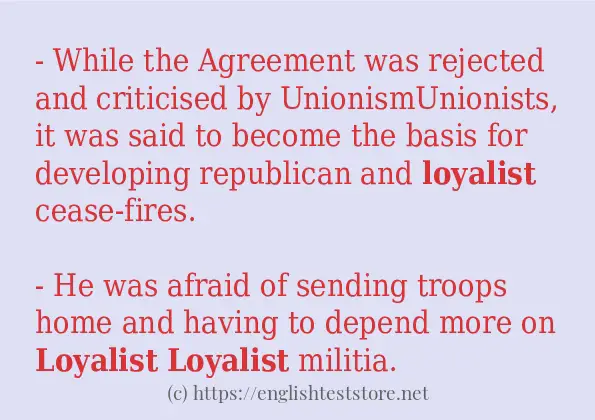How to use in-sentence of “loyalist”:
– While the Agreement was rejected and criticised by UnionismUnionists, it was said to become the basis for developing republican and loyalist cease-fires.
– He was afraid of sending troops home and having to depend more on Loyalist Loyalist militia.
– The house was built between 1785 and 1789 by rich butcher Edward Mooney on land that was originally part of the Doyer bouwerie and afterwards belonged to the British Loyalist James Delancey.
– Later, as a loyalist to the Flavians, he attained Roman consulconsulships in 71 and 90 during the reigns of Vespasian and Domitian respectively.
– He was long known as a loyalist of Hafez al-Assad, and held a strong position within the Syrian government until he resigned his positions and fled the country in 2005 in protest against certain policies of Hafez’s son and successor, Bashar al-Assad.
– Franklin was a steadfast Loyalist Loyalist throughout the American Revolutionary War.
– However, one of the loyalist generals, Ashikaga Takauji, betrayed Go-Daigo.

Example sentences of “loyalist”:
– Odell was a Loyalist working with William Franklin, the last Colonial Governor of Province of New JerseyNew Jersey and the son of Benjamin Franklin.
– Bayard liked the revolutionary cause but changed to a Loyalist Loyalist Tory in 1776 when the Rebels lost the New York and New Jersey Campaign.
– Despite the convention of maiden speeches being non-controversial, Livingstone alleged that Holroyd had been mistreated when he tried to expose MI5 collusion with loyalist paramilitaries in the 1970s and the part Captain Robert Nairac is alleged to have played.
– After the American War of Independence, the British resettled some 7,300 Loyalist Loyalists and their slaves in the Bahamas from New York, Florida, and the Carolinas.
– The first European settlers were Loyalist Loyalists who fled the American Revolution.
– The Contitution Act of 1791 is a law issued by the British Parliament under King George III in response to the demands of the United Empire Loyalist Loyalists asking for elected representation.
– The town was founded by Peter Clinch Peter Clinch, a United Empire Loyalist who emigrated from the United States in 1784.
– He defended two key Loyalist fortresses at Akasaka and Chihaya.
– Simcoe wanted to raise a Black Loyalist Loyalist regiment made entirely of freed slaves.
– He was known as a determined loyalist of Joseph Stalin, and in 1935 he wrote a paper in which he argued that political opposition must eventually lead to violence and terrorism; this became in part the ideological basis of the Purges.
– In 1984, Queen Elizabeth II named the highway between Trenton and Kingston the Loyalist Parkway.
– Later there was a new ceasefire, and there were talks between teams from the British and Irish governments, the Ulster Unionist Party, the SDLP, Sinn Féin and representatives of loyalist paramilitary organizations, under the chairmanship of former United States Senator Mitchell.
– The brutal police action against the Northern Ireland civil rights movement and the raids by loyalist paramilitaries in 1967 brought the IRA back on the map.
- Odell was a Loyalist working with William Franklin, the last Colonial Governor of Province of New JerseyNew Jersey and the son of Benjamin Franklin.
- Bayard liked the revolutionary cause but changed to a Loyalist Loyalist Tory in 1776 when the Rebels lost the New York and New Jersey Campaign.
- Despite the convention of maiden speeches being non-controversial, Livingstone alleged that Holroyd had been mistreated when he tried to expose MI5 collusion with loyalist paramilitaries in the 1970s and the part Captain Robert Nairac is alleged to have played.
